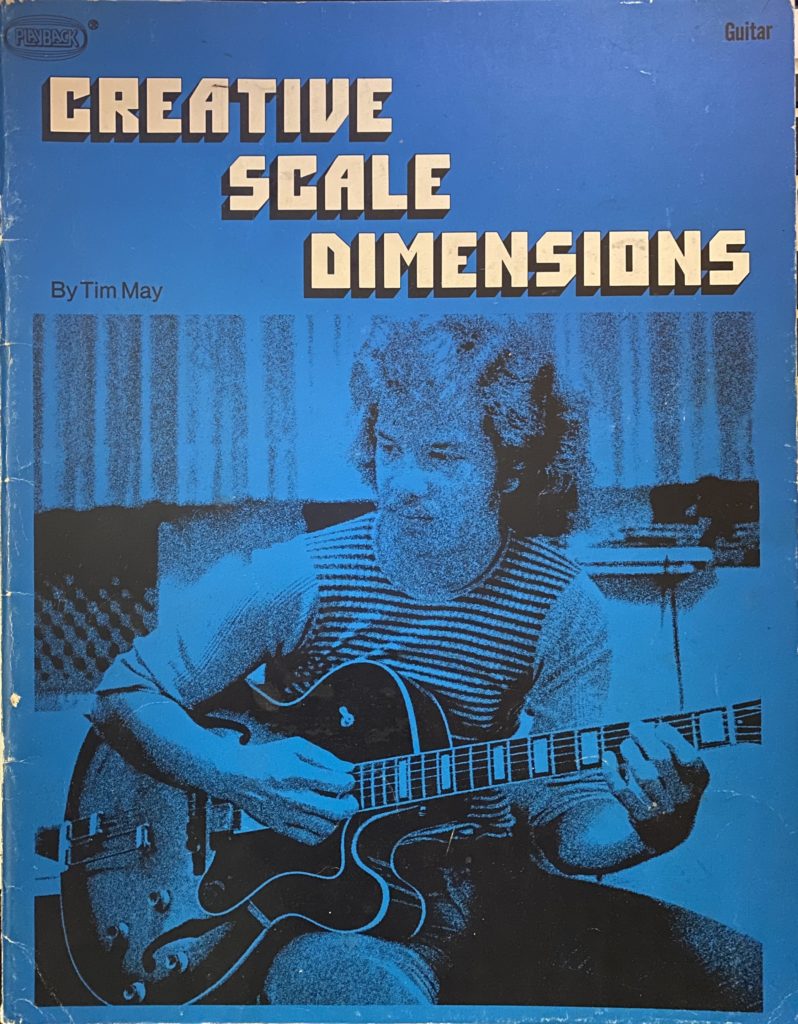
Session guitarist Tim May’s book Creative Scale Dimension was released in 1973 by Playback Music Publishing Company. If that sounds familiar, it’s because that’s legendary guitarist Howard Robert’s company that published his own early books.
At 40 pages, it might seem like this is a pretty slim book. However, the material here is some heavy stuff!
There are six chapters:
CHAPTER ONE
FINGERINGS
Explanation of chord symbols and book format
Strong and weak beats
Dissonance and Consonance
CHAPTER TWO
THE DIATONIC (MAJOR SCALE)
Major scale fingering
C Major scale against Major 7 chords
C Major scale against Minor 7 chords
C Major scale against Dominant 7 chords
Self Test
CHAPTER THREE
PENTATONIC SCALE
Pentatonic scale fingering
C Pentatonic scale against Major 7 chords
C Pentatonic scale against Minor 7 chords
C Pentatonic scale against Dominant 7 chords
Self Test
CHAPTER FOUR
THE HARMONIC MINOR SCALE (NATURAL AND MELODIC)
Minor scale fingering
C Harmonic Minor scale against Major 7 chords
C Harmonic Minor scale against Minor 7 chords
C Harmonic Minor scale against Dominant 7 chords
Self Test
CHAPTER FIVE
THE WHOLE TONE SCALE
Whole tone scale fingering
C Whole tone scale against Dominant 7 chords
Self Test
CHAPTER SIX
THE DIMINISHED SCALE
C Diminished scale fingerings
C Diminished scale against Dominant 7 chords
C Diminished scale against Diminished chords
Self Test
Etude
Answers to Self Tests
Basically, book begins with an introduction of some key concepts and music theory. Then, each chapters explores one scale and gives various examples of how the scale sounds over different chords.
At the end of each chapter, Tim also gives further suggestions on how to go deeper with the material so you can really develop your own opinions and perspective on what scales are available beyond the standard options.
I have to say that some parts of the book remind me of the kind of ideas that David Liebman covers in A Chromatic Approach to Jazz Harmony and Melody… except with Tim’s book it’s more guitar oriented (with the guitar fingerings and all). However the possibilities that Tim introduces in the book are advanced.
This isn’t a book for beginners and maybe even not for intermediate guitarists… but perhaps best suited for the serious advanced guitarist looking to find new sounds to play.
A lot of the benefits from the book require you to play the different scale options over a backing track or with someone playing the chords, to listen carefully to the sound & then decide which ones you like the most. Tim recommends making usable licks immediately once you find scale-chord relationships that you enjoy.
At the end of each chapter, there is also a “self test” which gives the you a chance to see whether you know the material well enough.
At the very end of the book, you also get an etude that uses the lines you’ve seen in the book in a solo.
In conclusion, this book is a valuable look at some outside sounds (new sounds) to scales you already know and play. In that regard, it succeeds tremendously. Definitely a unique book! I recommend this for any super curious harmonic adventurer interested in seeing what Tim had to say about this in 1973.
Pros: Unique perspective on scales, inside vs. outside playing, ear training and creating lines
Cons: This very much a do it yourself project… you need to really do the work, otherwise this book will just be a conceptual
TLDR: Wanna play outside? Want to have a different perspective on outside playing? Then you might like this book!
[How to find the book]
This book is rather difficult to find. You can try on Amazon or eBay and see whether any used copies are available. Good luck!
[Review Archive]
I wrote a lot of other book, course and video reviews too.
Check out the rest here:
[Read more reviews]
[Submissions for Review Consideration]
- Are you an author who wrote a jazz, guitar or music book?
- Have you created a DVD or an online video course or subscription based website?
- Would you like me to review your book/course?
Please send me a message at azsamad3 at gmail.com with:
For courses: a link to the course/video/product + access info etc.
For books: a link to the book (Dropbox) or PDF attachment (if it’s small) for review consideration.
Depending on whether I dig the book/course, I’ll let you know if I do plan to review it!
I cannot guarantee a review for every submission & if I’m not too into it, I may opt not to review it. I mean, it’s better to get a good review that for me to write a bad review just because it’s not a match for the kind of stuff I dig right? :p
NOTE: All reviews reflect my honest personal opinion so be aware that I will point out both cool Pros and Cons that I see in the work. You dig?
Leave a Reply